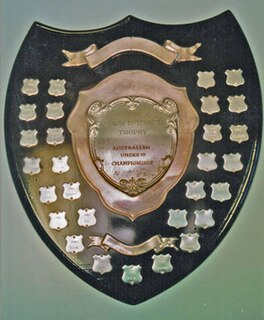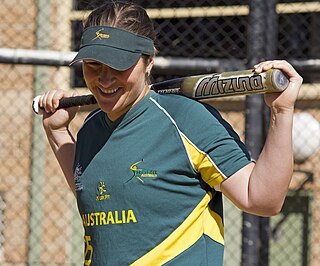
Australia's softball history began in 1939 when Gordon Young, Director of Physical Education in NSW, began to promote the game in schools and colleges. In 1942, during World War II, US army sergeant William Duvernet organised softball as a recreation for US nurses stationed in Victoria. Another American, Mack Gilley, introduced the game to Queensland in 1946. Australia's first inter-state championship was played in Brisbane in 1947 and was won by Victoria. The second national championship was held in Melbourne two years later. It was at this championship that the Australian Softball Federation was formed with Queensland, Victoria, South Australia and New South Wales being the founding members. The other States of Australia have since joined. Eight Australian Championships are now conducted each year - Women's, Men's, Under 23 Women and Men, Under 19 Women and Men, and Under 16 Girls and Boys. Softball has been a major sport in the schools program for some time now and it is estimated that more than 250,000 children play the game each year.

The Gilleys Shield is a trophy symbolising the Open Women's Championship of the Softball Australia organisation. The competition's full name is the Mack Gilley Shield.

The Elinor McKenzie Shield is a trophy symbolizing the Under 19 Women's Championship of Softball Australia.

Softball at the Summer Olympics was on the Olympic programme from 1996 to 2008. It was introduced at the 1996 Atlanta Olympics. Softball was removed from the programme for 2012 and 2016, but was added, along with baseball, for the 2020 Summer Olympics.
Softball in Australia is played in Australia.

Brenda De Blaes is an Australian softball player. She resides in Canberra where she plays club softball and represents the territory in national competitions. She is a member of the Australia women's national softball team and has competed at the 2009 World Cup and the 2010 World Cup of Softball. She is vying for a spot on the team that will compete at the 2012 ISF XIII Women's World Championships.

Aimee Murch is an Australian softball player. She plays for the Australian Capital Territory (ACT) in national competitions, and for a local ACT club. She plays for the Australia women's national softball team. She is trying to earn a spot on the roster that will allow her to compete at the 2012 ISF XIII Women's World Championships. She plays professional softball in Italy for Nuoro.
Softball is played in Queensland .
Softball is played in New South Wales, introduced to the state in 1939. By 1984, there were 1,356 registered teams in New South Wales. Players from Australia have been on the men's and women's national team, had AIS scholarships, played at universities in the United States, and professionally in the USA, Japan and Europe.
Softball is played in the Australian state of Victoria.
Softball is played in Tasmania. The game was brought to the island during the late 1940s from Melbourne, Victoria. The sport would grow in popularity in Tasmania with 56 teams in 1976 to 216 in 1984. Men's softball is not popular in Tasmania. The first softball only facility was built in Tasmania in 1984.
Softball is played in South Australia.
Softball is played in Western Australia.
Softball is played in the Northern Territory, Australia.
The Australia men's national softball team is the national softball team of Australia. They are nicknamed the Australian Steelers. The team is governed by Softball Australia and takes part in international softball competitions.
Zimbabwe men's national softball team is the national softball team for Zimbabwe. The 1988 World Championships were held in Saskatoon, Canada. The team played 13 games in the round robin round. Australia beat Zimbabwe 2–0 in one game in this round.
The Virgin Islands men's national softball team is the top men's softball team for the territory of the Virgin Island.
Cuba men's national softball team represents Cuba in international softball competitions. The team played at the 1988 World Championships were held in Saskatoon, Canada. They played 13 games in a round robin tournament, and beat Australia 7–4 in one game.
Guam men's national softball team is the national team for Guam. The 1992 World Championships, the eighth time the event was competed for, was held in Manila. Australia beat Guam 7–2 in one game in the first round robin round.
Czechoslovakia men's national softball team is the national team for Czechoslovakia.







